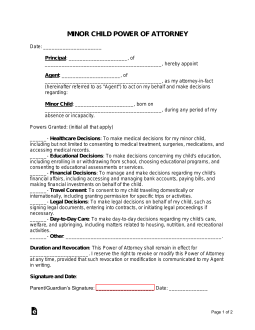Updated February 23, 2024
Minor (child) power of attorney is a legal document that allows a parent to grant someone else the responsibility for their children for a specified period. Responsibilities usually include daily care, and making educational, healthcare, and travel decisions.
Signing Requirements
A minor (child) power of attorney is recommended to be notarized. If the parents would like to designate a longer-term arrangement, they should apply for guardianship.
Maximum Period
Child power of attorney has a maximum limit of 6-12 months (see State laws). There is no limit on the number of times it can be renewed.
By State
- Alabama
- Alaska
- Arizona
- Arkansas
- California
- Colorado
- Connecticut
- Delaware
- Florida
- Georgia
- Hawaii
- Idaho
- Illinois
- Indiana
- Iowa
- Kansas
- Kentucky
- Louisiana
- Maine
- Maryland
- Massachusetts
- Michigan
- Minnesota
- Mississippi
- Missouri
- Montana
- Nebraska
- Nevada
- New Hampshire
- New Jersey
- New Mexico
- New York
- North Carolina
- North Dakota
- Ohio
- Oklahoma
- Oregon
- Pennsylvania
- Rhode Island
- South Carolina
- South Dakota
- Tennessee
- Texas
- Utah
- Vermont
- Virginia
- Washington
- Washington D.C.
- West Virginia
- Wisconsin
- Wyoming
Table of Contents |
How to Get Minor Power of Attorney
- Parent Selects an Agent
- Start and End Dates
- Powers and Responsibilities
- Signing the Form
- Using the Form
1. Parent Selects an Agent

A parent or legal guardian of a child has the authority to choose someone else (agent) to have rights over their child.
The agent selected will have rights over the child’s daily care along with educational, health, and dietary conditions. Therefore, the agent selected should be a trustworthy individual.
2. Start and End Dates

Most States do not allow a power of attorney designation for more than 6-12 month. Even though it can be renewed, it is best to check with State law.
Maximum Time Periods
| State | Maximum Period | Statutes |
| Alabama | 1 year | § 26-2A-7 |
| Alaska | 1 year | AS 13-26-066(c) |
| Arizona | 6 months | ARS § 14-5104 |
| Arkansas | Not mentioned | |
| California | Not mentioned | § 1510-1517 |
| Colorado | 12 months | § 15-14-105 |
| Connecticut | 1 year | Sec. 45a-622 |
| Delaware | Not mentioned | § 2320 to § 2328 |
| Florida | Not mentioned | § 744.3021 |
| Georgia | Not mentioned | § 19-9-124 |
| Hawaii | 1 year | §560:5-105 |
| Idaho | 6 months | § 15-5-104 |
| Illinois | Not mentioned | 755 ILCS 45 |
| Indiana | 12 months | § 29-3-9-1 |
| Iowa | No laws | No laws |
| Kansas | 1 year | § 38-2403(d)(2)(A) |
| Kentucky | Not mentioned | 27A.095 |
| Louisiana | No laws | No laws |
| Maine | 12 months | § 5-127 |
| Maryland | No laws | No laws |
| Massachusetts | Not mentioned | § 5-202 |
| Michigan | 180 days | Sec. 700.5103(1) |
| Minnesota | Not mentioned | § 257B.04 |
| Mississippi | No laws | No laws |
| Missouri | 1 year | § 475.602 |
| Montana | 6 months | § 72-5-103 |
| Nebraska | 6 months | Statute 30-2604 |
| Nevada | 6 months | NRS 159.0613 |
| New Hampshire | No laws | No laws |
| New Jersey | 1 year | |
| New Mexico | 6 months | |
| New York | Not mentioned | FCT § 661 |
| North Carolina | Not mentioned | § 32A-28 to § 32A-34 |
| North Dakota | 6 months | § 30.1-27-07(3) |
| Ohio | Not mentioned | § 3109.52 to § 3109.61 |
| Oklahoma | 1 year | |
| Oregon | 6 months | |
| Pennsylvania | Not mentioned | 11 Pa. Stat. § 2513 |
| Rhode Island | Not mentioned | § 33-15.1-14 |
| South Carolina | Not mentioned | |
| South Dakota | Not mentioned | § 29A-5-201 |
| Tennessee | Not mentioned | |
| Texas | Not mentioned | Sec. 1104.052 |
| Utah | 6 months | § 75-5-103 |
| Vermont | Not mentioned | 14 V.S.A. § 2659 |
| Virginia | 180 days | § 20-166(A) |
| Washington | Not mentioned | RCW 11.125.410 |
| Washington D.C. | Not mentioned | |
| West Virginia | Not mentioned | Chapter 44a, Article 1 |
| Wisconsin | 1 year | § 48.979(1)(am) |
| Wyoming | Not mentioned | Section 3-2-202 |
Sample
MINOR CHILD POWER OF ATTORNEY
Date: [EFFECTIVE DATE]
Principal: [PRINCIPAL’S NAME], of [PRINCIPAL’S ADDRESS], hereby appoint
Agent: [AGENT’S NAME], of [AGENT’S ADDRESS], as my attorney-in-fact (hereinafter referred to as “Agent”) to act on my behalf and make decisions regarding:
Minor Child: [CHILD’S NAME], born on [CHILD’S DATE OF BIRTH], during any period of my absence or incapacity.
Powers Granted: (initial all that apply)
______- Healthcare Decisions: To make medical decisions for my minor child, including but not limited to consenting to medical treatment, surgeries, medications, and accessing medical records.
______- Educational Decisions: To make decisions concerning my child’s education, including enrolling in or withdrawing from school, choosing educational programs, and consenting to educational assessments or services.
______- Financial Decisions: To manage and make decisions regarding my child’s financial affairs, including accessing and managing bank accounts, paying bills, and making financial investments on behalf of the child.
______- Travel Consent: To consent to my child traveling domestically or internationally, including granting permission for specific trips or activities.
______- Legal Decisions: To make legal decisions on behalf of my child, such as signing legal documents, entering into contracts, or initiating legal proceedings if necessary.
______- Day-to-Day Care: To make day-to-day decisions regarding my child’s care, welfare, and upbringing, including matters related to housing, nutrition, and recreational activities.
______- Other: [DESCRIBE].
Duration and Revocation: This Power of Attorney shall remain in effect for [DURATION]. I reserve the right to revoke or modify this Power of Attorney at any time, provided that such revocation or modification is communicated to my Agent in writing.
Signature and Date:
Parent/Guardian’s Signature: _____________________ Date: ______________
Witnesses:
Witness #1 Signature: _____________________ Date: ______________
Witness #2 Signature: _____________________ Date: ______________
Agent Acceptance:
I, the Agent, accept the responsibilities and duties as the attorney-in-fact for the parent/legal guardian mentioned under this Power of Attorney.
Agent Signature: _____________________ Date: ______________





